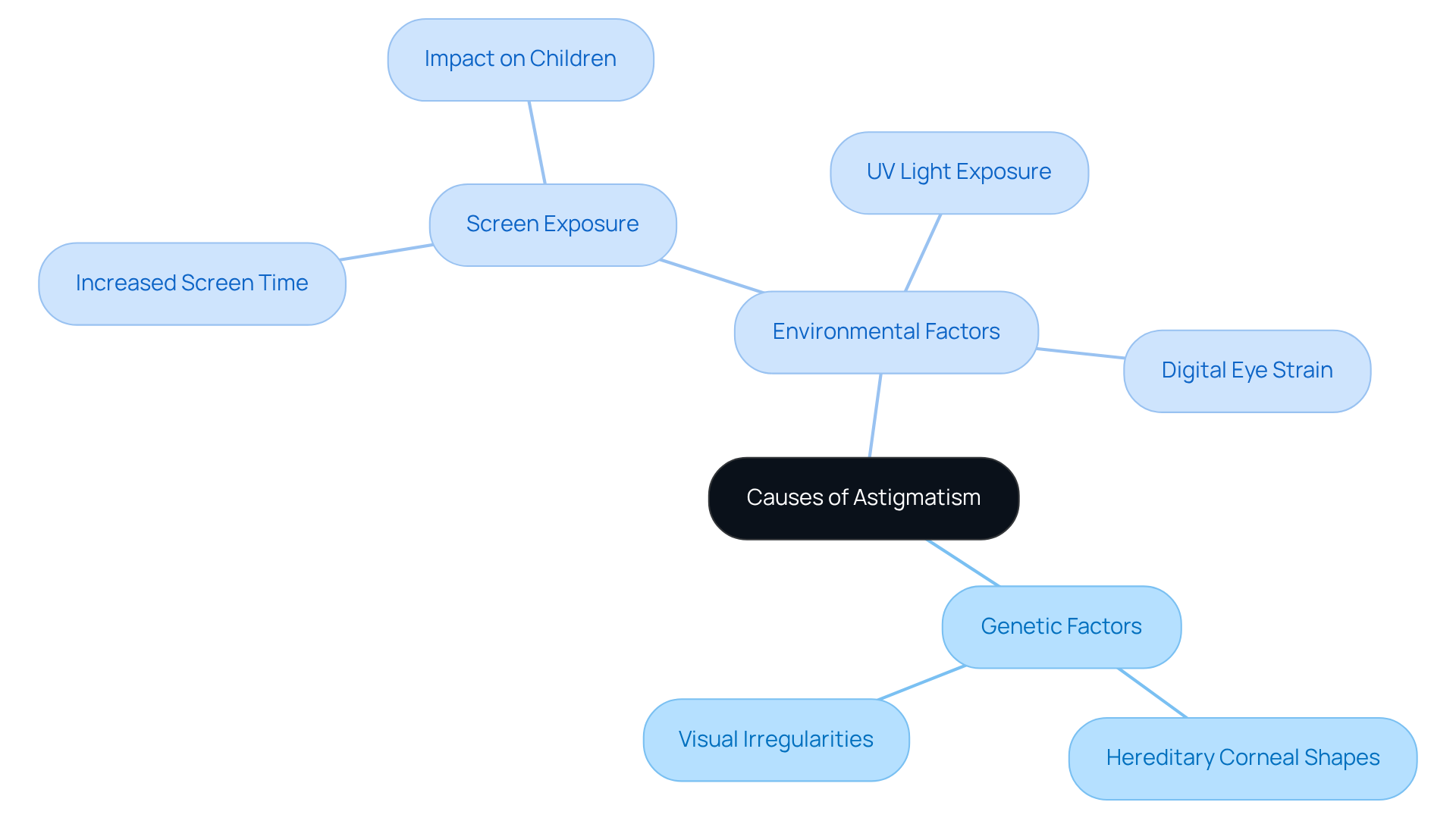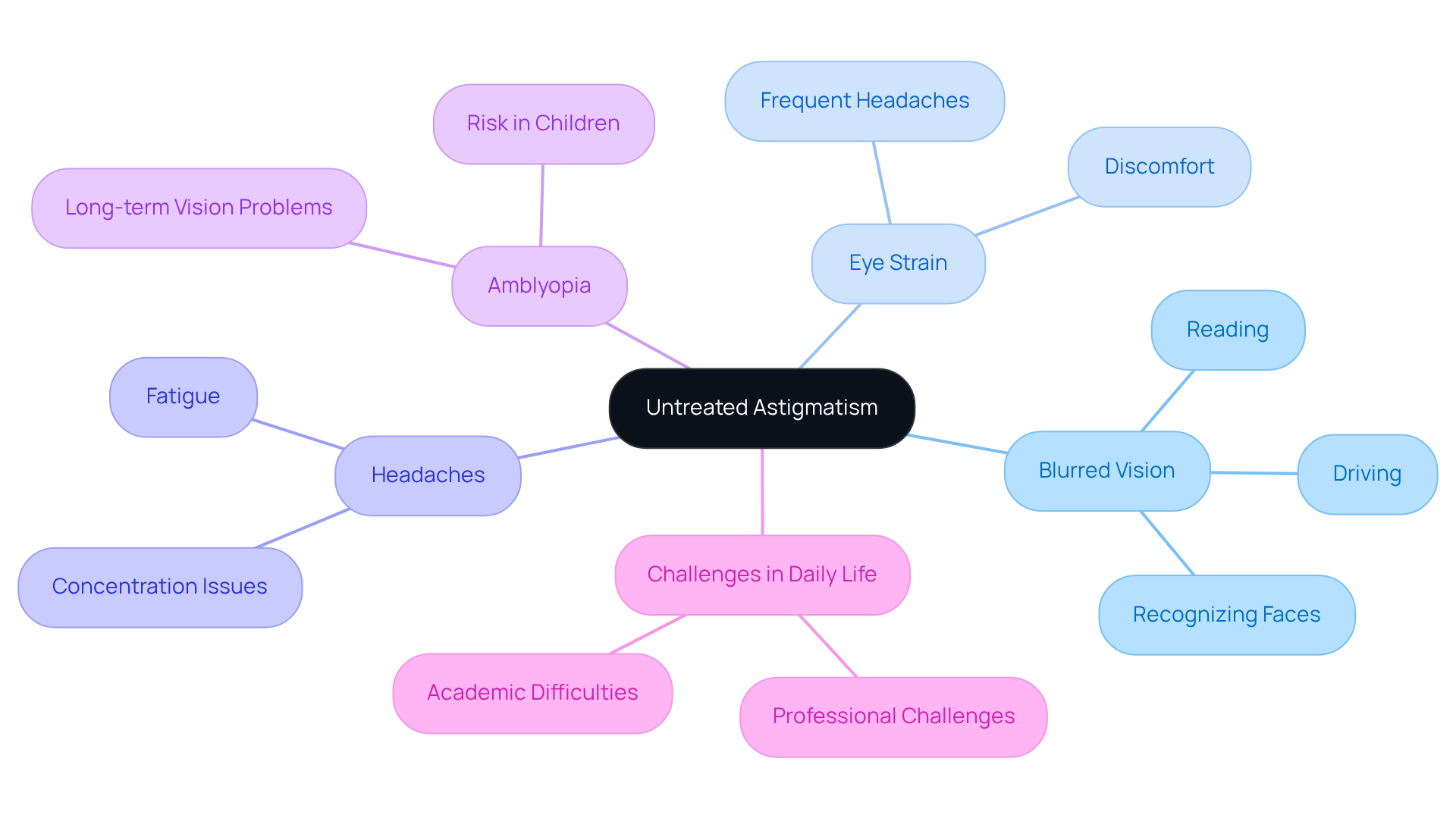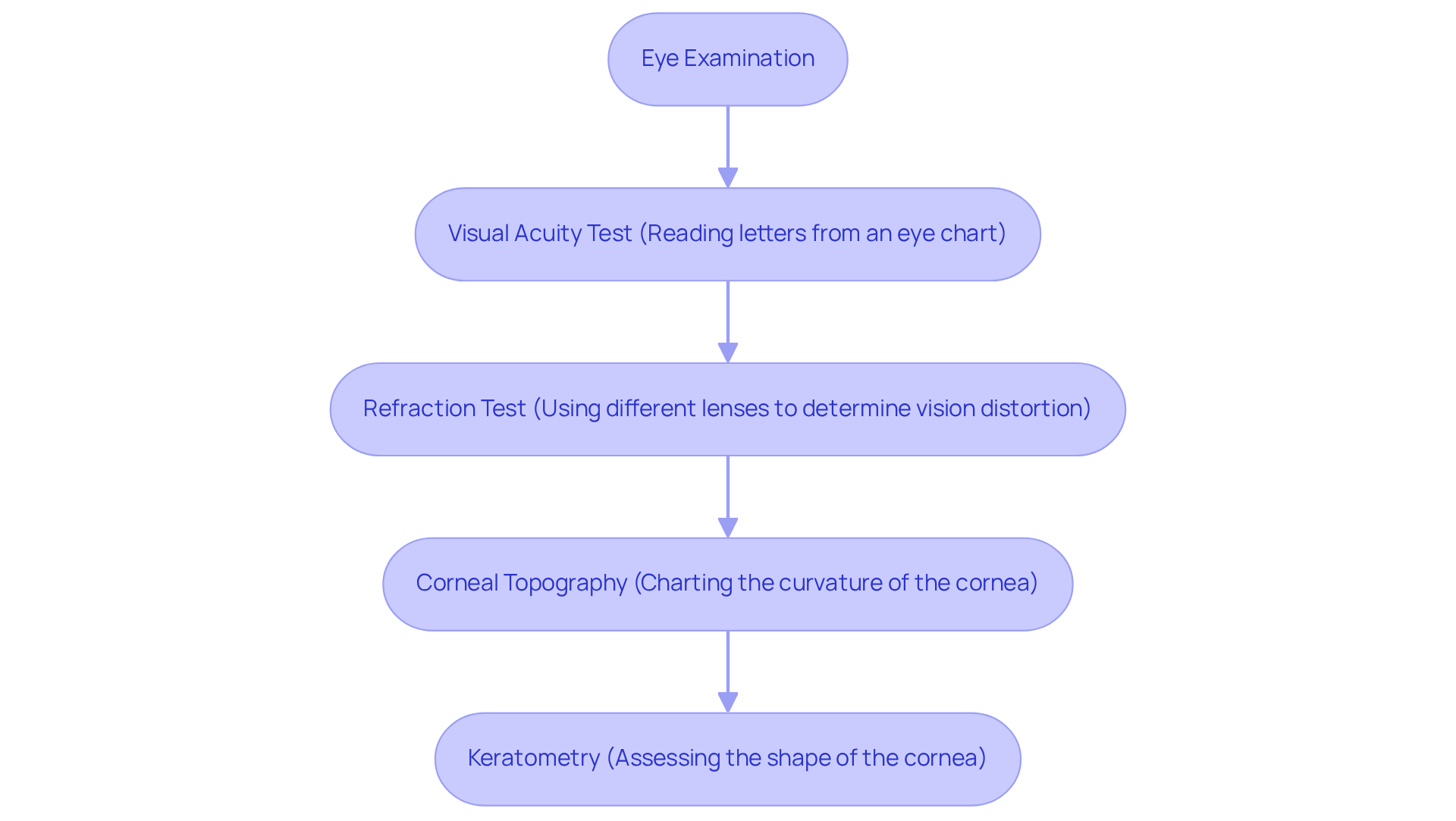Posted by: Northwest Eye in Astigmatism on November 3, 2025
Overview
Astigmatism can really affect your vision, leading to blurred or distorted sight. This happens because of the irregular shape of the cornea or lens, and it can make daily activities challenging. We understand that living with this condition can impact your overall well-being.
It’s important to know that untreated astigmatism can lead to complications like:
- Eye strain
- Headaches
- Amblyopia
This highlights the need for proper diagnosis and management. We want you to feel reassured that there are effective corrective measures available, such as:
- Glasses
- Contact lenses
- Surgery
Taking action is crucial. If you’re experiencing symptoms, please consider reaching out for an eye exam. Remember, you’re not alone in this journey, and we are here to help you through the process.
Introduction
Astigmatism affects a significant portion of the population, and we understand that many may feel uncertain about its implications for vision health. This common refractive error arises from irregularities in the cornea or lens, leading to blurred vision and discomfort. It’s natural to wonder: is astigmatism bad for your vision?
Understanding the risks associated with untreated astigmatism is essential for maintaining visual clarity and overall quality of life. When this condition goes unaddressed, challenges can arise that impact daily activities and well-being. We want to help you navigate your options for effective management, ensuring you feel supported every step of the way.
Define Astigmatism: What It Is and How It Affects Vision
Astigmatism is a common refractive error, and many people wonder if astigmatism is bad. It occurs when the cornea or lens has an irregular shape, much like a football, rather than being perfectly round. This irregularity causes light to focus unevenly on the retina, leading to blurred or distorted vision at all distances, which makes one wonder, is astigmatism bad? We understand that this can be concerning, especially since it affects about 40.4% of adults and 14.9% of children worldwide. Rates can vary significantly by region, with studies showing that up to 62% of people in China and around 54% in Spain and Japan are impacted.
Key symptoms of astigmatism include:
- Difficulty seeing clearly
- Eye strain
- Headaches
- Squinting
These issues can really affect your daily life and overall well-being. Research indicates that individuals with uncorrected refractive errors perform vision-related tasks 9% slower at 1.00 D and 29% slower at 2.00 D compared to those with corrected vision. This highlights the importance of seeking prompt diagnosis and management.
Recent studies have shown that there are effective ways to manage astigmatism. Most cases can be effectively treated with:
- Prescription eyeglasses
- Contact lenses
- Refractive surgery, such as LASIK
For instance, toric intraocular lenses have demonstrated high patient satisfaction, with over 70% of individuals reporting positive outcomes. We want to emphasize the importance of regular eye check-ups to ensure accurate diagnosis and treatment, helping to prevent complications like amblyopia that can arise from untreated vision issues.
If you’re feeling uncertain or worried about your vision, remember that you’re not alone. Many people have successfully navigated this journey, and we are here to help you through the process. Taking the first step towards addressing your vision concerns can lead to a clearer, more comfortable life.

Identify Causes of Astigmatism: Genetic and Environmental Factors
Many people worry about astigmatism, leading to the question of whether is astigmatism bad, as it arises from a complex interplay of genetic and environmental factors. We understand that genetics plays a significant role, as many individuals inherit corneal shapes from their parents. Studies have shown a hereditary inclination for visual irregularities, which can be worrying.
However, it’s important to recognize that environmental factors also contribute significantly to the development and progression of astigmatism. For instance, extended screen exposure, especially in children, has been linked to higher rates of vision issues. Recent studies indicate a concerning increase in vision problems among Hong Kong youngsters aged 6 to 8 years, rising from 23.4% to 34.7% after COVID-19. This change is largely attributed to lifestyle modifications, such as increased screen time and reduced outdoor activities.
Moreover, excessive UV light exposure and digital eye strain are recognized factors that can worsen vision irregularities. Understanding these environmental influences is crucial for effective prevention and management strategies. We want to reassure you that timely intervention can help mitigate the risks associated with this common refractive error, which raises the question, is astigmatism bad?
If you have concerns about your vision or that of your loved ones, remember that we are here to help you through this process. Together, we can explore ways to protect and improve your eye health.

Examine Risks of Untreated Astigmatism: Impact on Daily Life and Vision Quality
Untreated refractive errors can lead to complications that significantly impact your daily life and overall vision quality, which makes one wonder, is astigmatism bad? We understand that experiencing persistent blurred vision can make activities like reading, driving, and recognizing faces challenging. Moreover, neglecting these vision issues and not considering if is astigmatism bad may result in eye strain and discomfort, often causing frequent headaches and fatigue. In severe cases, it could even contribute to the development of amblyopia, or ‘lazy eye,’ especially in children, which leads to concerns about whether is astigmatism bad.
The Mayo Clinic highlights that individuals with untreated vision problems, including whether is astigmatism bad, may face difficulties in academic and professional settings due to reduced visual performance. It’s common to feel overwhelmed by these challenges, but identifying and addressing refractive errors is crucial for maintaining your sight and enhancing your quality of life. Remember, we are here to help you through this process.

Outline Diagnosis of Astigmatism: Tests and Procedures Involved
Diagnosing a vision condition can feel overwhelming, but rest assured, a thorough eye examination by a caring eye care professional can provide clarity. During this process, various key tests are utilized to ensure an accurate assessment. The visual acuity test is foundational; here, patients read letters from an eye chart to evaluate the clarity of their vision. Following this, a refraction test is conducted, using different lenses to determine the exact level of vision distortion. Advanced diagnostic instruments, like corneal topography and keratometry, play essential roles. Corneal topography charts the curvature of the cornea, while keratometry assesses its shape, offering detailed insights into the characteristics of your eye condition.
We understand that advancements in diagnostic methods can bring hope. Recent innovations have significantly improved detection rates and treatment outcomes. For instance, the integration of Optical Coherence Tomography (OCT) allows for high-resolution imaging of the eye’s internal structures, enhancing our understanding of astigmatic conditions. Ophthalmologists emphasize the importance of these assessments, noting that early identification through routine eye examinations can prevent issues linked to unmanaged refractive errors, such as reduced visual sharpness and increased glare. Symptoms like halos—those bright circles around light sources—and glare can be particularly troublesome, especially during nighttime driving.
Dr. Bharat Gurnani reminds us, “The effects of this condition on visual clarity can be significant, making prompt diagnosis crucial.” In real-world applications, comprehensive eye exams that include these diagnostic techniques have shown improvements in outcomes for individuals. For example, those identified with a refractive error through corneal topography often receive customized treatment strategies tailored to their unique visual needs. This proactive approach not only enhances sight quality but also supports overall eye health, underscoring the importance of regular eye examinations.
It’s common to feel concerned about whether astigmatism is bad, as it can lead to significant productivity losses. Patients may experience increased glare (53-77%) and halos (28-80%), highlighting both the economic burden and the importance of addressing blurred vision caused by various factors, including refractive errors and eye diseases. Remember, we are here to help you through this process, ensuring you receive the care and support you need.

Conclusion
Astigmatism is a common refractive error, but it can significantly impact your vision quality and daily life if not addressed. We understand that dealing with blurred vision and potential complications like amblyopia can be concerning. That’s why it’s crucial to seek timely diagnosis and appropriate management. Effective treatments, such as prescription eyewear or refractive surgery, can greatly enhance your visual clarity and overall well-being.
Throughout this article, we’ve highlighted key insights, including:
- The genetic and environmental factors that contribute to astigmatism
- The risks of leaving it untreated
- The diagnostic procedures available
Awareness and proactive measures are essential in overcoming the challenges posed by astigmatism. Regular eye examinations and understanding the symptoms can lead to early intervention, helping to prevent further complications and improve your quality of life.
In light of these findings, prioritizing your eye health is essential. It’s common to feel uncertain about vision changes, but whether through routine check-ups or educational resources, taking action can lead to clearer vision and a more comfortable daily experience. Embracing proactive eye care not only reduces the risks associated with astigmatism but also empowers you to navigate your visual health with confidence. We are here to help you through this process.
Frequently Asked Questions
What is astigmatism?
Astigmatism is a common refractive error that occurs when the cornea or lens has an irregular shape, causing light to focus unevenly on the retina, which leads to blurred or distorted vision at all distances.
How prevalent is astigmatism?
Astigmatism affects approximately 40.4% of adults and 14.9% of children worldwide, with significant regional variations, such as up to 62% of people in China and around 54% in Spain and Japan being impacted.
What are the key symptoms of astigmatism?
Key symptoms include difficulty seeing clearly, eye strain, headaches, and squinting.
How does uncorrected astigmatism affect daily life?
Individuals with uncorrected refractive errors perform vision-related tasks significantly slower, with research indicating a 9% slower performance at 1.00 D and a 29% slower performance at 2.00 D compared to those with corrected vision.
What are the treatment options for astigmatism?
Most cases of astigmatism can be effectively treated with prescription eyeglasses, contact lenses, or refractive surgery, such as LASIK.
What is the success rate of toric intraocular lenses in treating astigmatism?
Toric intraocular lenses have shown high patient satisfaction, with over 70% of individuals reporting positive outcomes.
Why are regular eye check-ups important for astigmatism?
Regular eye check-ups are important for accurate diagnosis and treatment of astigmatism, helping to prevent complications like amblyopia that can arise from untreated vision issues.
What should I do if I am concerned about my vision?
If you are feeling uncertain or worried about your vision, it is important to seek help and take the first step towards addressing your concerns, as many people have successfully managed similar issues.






